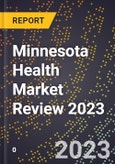After posting record profits and gaining enrollment in 2022, Minnesota HMOs continued their profitability and enrollment growth through the first half of 2023. Medicaid and other public programs are the largest lines of business for Minnesota HMOs and the source of most of their profits.
These and other findings are reported in Part One of Minnesota Health Market Review 2023.. First published in 1990, this is the 34th edition of the report, which analyzes key trends and competitive strategies for health plan companies and hospital systems operating in Minnesota. Part Two of the report, to be released later this year, will present our analysis of the state’s hospital systems and how they compete, examining 2022 data on their financial performance and measures of inpatient utilization.
The new report finds that:
- Enrollment in Minnesota HMOs grew by 3% and they reported average profit margins of 3.2% in the first half of 2023. Enrollment grew to 1.651 million, the highest HMO membership in history. Enrollment has grown by 28.8% since the end of 2019, in the first three years of the COVID-19 pandemic. Most of the growth has been in Medicaid-managed care and other public programs, which now cover about 24% of the state’s population. UCare grew by 54.2%, while Blue Plus added 20.6% and the new UnitedHealthcare HMO went from zero to about 39,000 members.
- In the first half of 2023, Minnesota HMOs reported net income of $213.4 million, or 3.2% of underwriting revenues. Four HMOs--Blue Plus, UCare, UnitedHealthcare and Hennepin Health--reported margins of 5% or higher. This comes after HMOs and County-Based Purchasing plans for public programs posted record profits in 2022 of $720.8 million, driven by net income from state public programs, especially Medicaid ($478.2 million) and Minnesota Senior Health Options ($137.2 million). UCare accounted for $325.7 million of that, with about 85% coming from its public program contracts. In 2016, UCare was struggling with the loss of state contracts and revenues and agreed to be acquired by Fairview Health, although that deal was later cancelled.
- Enrollment in Medicare Advantage HMO and PPO plans in Minnesota increased by almost 47,000 as of January 2023. In 2023, 55% of the state’s Medicare beneficiaries in the state are in Medicare health plans, above the national average. UCare’s HMO plans have grown to 135,000 and Blue Cross Blue Shield increased enrollment in its Medicare PPO plans from 162,000 to more than 212,000. Enrollment in Humana’s PPO plans has dropped as several major provider systems dropped out of the Humana
- Spending on administrative expenses increased by about $278 million for Minnesota HMOs, reaching $1.395 billion in 2023, or 9.3% of underwriting revenues. Expenses for UCare increased by $124 million, including $28 million in contributions to its own foundations. Administrative spending for Blue Plus increased by $!00 million.
- Even with large transfers of dividends to parent companies and investments outside of Minnesota, capital accumulated by HMOs has almost doubled in the last five years. Minnesota HMOs added $526 million to their capital in 2022, reaching $3.773 billion, three times as much as the minimum required by state law. Since 2020, Medica Insurance Company paid dividends of $575 million to its parent company, while Blue Cross Blue Shield transferred $208.3 million to its parent company.
Please Note: Price Includes a subscription to parts one and two of the report.
Table of Contents
IntroductionMarket Structure
- Health Plan Companies
- Network Arrangements and Provider Systems
- Health Plan Enrollment
- Individual Markets and MNsure
- State Healthcare Programs
- Medicare Health Plans
- Health Plan Net Income.
- Financial Results by Line of Business
- Administrative Expenses
- Health Plan Capital
Methodology
The reports analyzing state health care markets are intended to be a resource to health care organizations facing a full range of challenges but also seeking to identify and benefit from opportunities that present themselves.
This report is presented in three main sections. The first part, Market Structure, describes the major health insurers and hospital systems in the state, showing recent entrants and the high-level of consolidation that has occurred in both the health plan and provider markets. Market Trends, the next section, presents our analysis of enrollment trends and financial results for the health insurers. The last section contains our analysis of financial and inpatient utilization data on the hospitals in the state.
The analysis of health plan companies is based on their annual and quarterly statements filed with the Department of Insurance, including forms prescribed by the National Association of Insurance Commissioners and supplemental reports required by the state. The publisher also uses Medicaid data from the Department of State Health Services and Medicare health plan and hospital data from the Centers for Medicare and Medicaid Services. The publisher has that data together with insights that they have gained in interviews with dozens of leaders in health care organizations in the state.

LOADING...








